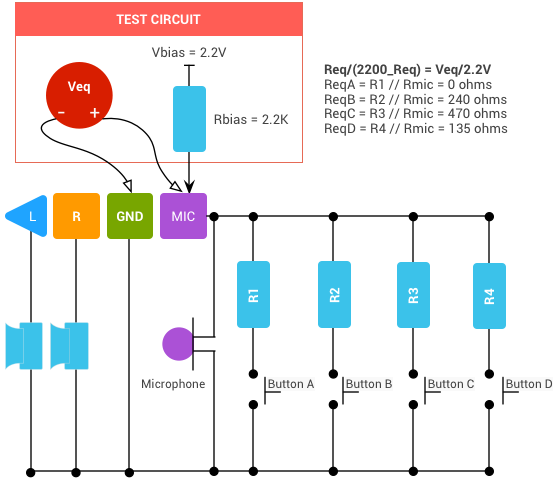이 문서에서는 Android 생태계에서 3.5mm 플러그 헤드셋이 균일하게 작동하기 위한 요구사항을 설명합니다.
기기 제조업체는 3.5mm 잭 사양 및 Android 호환성 정의 문서(CDD)에서 추가 요구사항을 확인해야 합니다.
기능
| 기능 | 액세서리 지원 |
|---|---|
| 스테레오 오디오 출력 | 필수 |
| 오디오 입력(마이크) | 필수 |
| 접지 | 필수 |
제어 기능 매핑
| 제어 기능 | 액세서리 지원 | 설명 |
|---|---|---|
| 기능 A | 필수 | 재생/일시중지/후크(짧게 누르기), 트리거 지원(길게 누르기), 다음(두 번 누르기) |
| 기능 B | 선택사항 | 볼륨 높이기 |
| 기능 C | 선택사항 | 볼륨 낮추기 |
| 기능 D | 선택사항 | 예약됨(Pixel 기기는 이 기능을 사용하여 음성 명령어를 실행함) |
버튼에 기능을 할당하는 방법은 다음과 같습니다.
- 버튼이 하나인 모든 헤드셋은 기능 A를 구현해야 합니다.
- 버튼이 여러 개인 헤드셋은 다음 패턴에 따라 기능을 구현해야 합니다.
- 2가지 기능: A와 D
- 3가지 기능: A, B, C
- 4가지 기능: A, B, C, D
하드웨어
| 기능 | 액세서리 지원 | 메모 |
|---|---|---|
| 4 도체 3.5mm 플러그 | 필수 | 참조: EIAJ-RC5325A 표준 |
| CTIA 핀 배열(LRGM) | 필수 | OMTP 핀 배치에 대한 법적 요건이 있는 지역 제외 |
| OMTP 핀 배열(LRMG) | 선택사항 | |
| 마이크 | 필수 | 헤드셋을 제어할 때 가려지지 않아야 합니다. |
전기
| 기능 | 액세서리 지원 | 설명 |
|---|---|---|
| 이어 스피커 임피던스 | 16Ω 이상 | 32~300Ω 권장 |
| 마이크 직류 저항 | 1,000Ω 이상 | 마이크 특성은 현재 Android CDD의 섹션 5.4 오디오 녹음을 준수해야 합니다. |
| 제어 기능 등가 임피던스* | 0Ω | [기능 A] 재생/일시중지/후크 |
| 240Ω +/- 1% 저항 | [기능 B] | |
| 470Ω +/- 1% 저항 | [기능 C] | |
| 135Ω +/- 1% 저항 | [기능 D] |
*2.2kΩ 저항을 통해 2.2V 마이크 바이어스가 적용된 상태에서 버튼을 눌렀을 때 포지티브 마이크 단자에서 GND까지의 총 임피던스
다음 다이어그램에서 버튼 A는 기능 A, 버튼 B는 기능 B 등에 매핑됩니다.
참조 헤드셋 테스트 회로
참조 헤드셋 테스트 회로 1의 다음 다이어그램은 4 세그먼트 플러그의 CTIA 핀 배치를 보여줍니다. OMTP 핀 배치의 경우 MIC 및 GND 세그먼트의 위치를 전환합니다.

그림 1. 참조 헤드셋 테스트 회로 1
참조 헤드셋 테스트 회로 2의 다음 다이어그램은 이 사양에 맞게 실제 저항 값(R1 - R4)이 변경되는 방법을 보여줍니다.

그림 2. 참조 헤드셋 테스트 회로 2
마이크(R1-R4)와 병렬 상태인 버튼의 실제 저항은 마이크 캡슐 저항(Rmic) 및 등가 임피던스 값(ReqA-ReqD)을 기반으로 합니다. 다음 수식을 사용합니다.
ReqN=(Rmic*Rn)/(Rmic+Rn)
R n은 버튼의 실제 저항이고, Req N은 버튼(제공됨)의 등가 임피던스 값이며 Rmic는 마이크 임피던스 값입니다.
위의 예에서는 마이크 임피던스(Rmic)가 5kΩ이라고 가정합니다. 135Ω의 등가 R4 임피던스(ReqD)를 달성하려면 실제 저항 값(R4)은 139Ω이어야 합니다.

